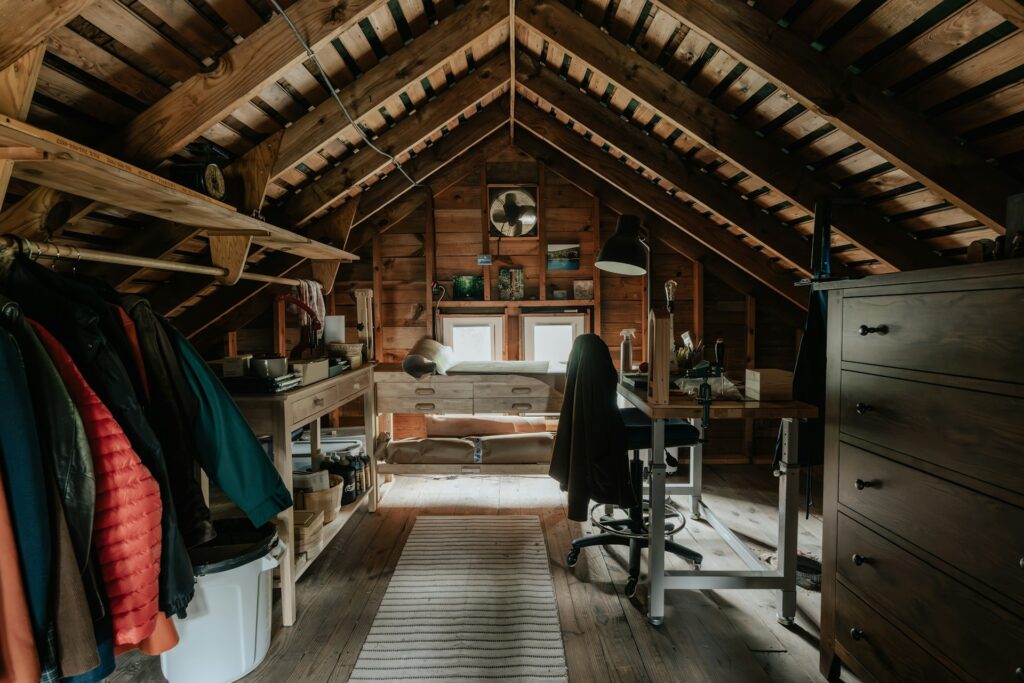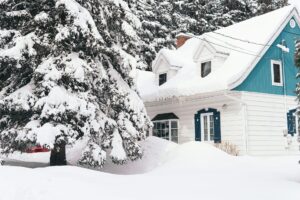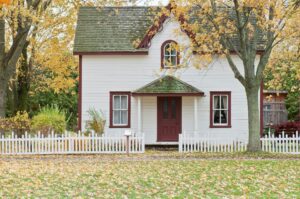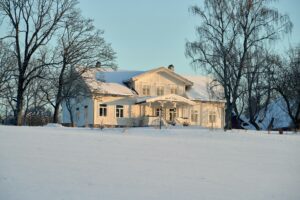Autumn in Salem, Oregon, signals the arrival of steady rainfall and humidity that will persist through winter. As the rainy season approaches, your roof and skylights become your home’s first line of defense against water intrusion. While many homeowners focus solely on gutter cleaning, the most critical preparations involve securing your roofing system and skylights, along with optimizing attic ventilation and insulation to prevent moisture damage from within.
When rain and moisture hover for months on end, vulnerable areas like skylight seals, roof flashing, and inadequate attic ventilation can lead to costly leaks, mold growth, and structural damage. This guide explores how to winterize your Salem roof and skylights this fall, while integrating proper ventilation and insulation strategies to keep your home dry, efficient, and protected all season long.
Securing Skylights for Salem’s Rainy Season
Skylights are a beautiful source of natural light, but they’re also one of the most vulnerable points in your roof system during Salem’s wet fall and winter months. As rain pounds down week after week, even small gaps in skylight flashing or aging seals can allow water to seep into your home, causing ceiling stains, mold growth, and structural damage.
Common Skylight Vulnerabilities
• Degraded Flashing: The metal flashing around skylights bridges the gap between the skylight frame and your roof. Over time, it can rust, crack, or separate, creating an entry point for water.
• Worn Seals: Skylight seals deteriorate due to UV exposure and temperature fluctuations. Once compromised, water can penetrate around the frame during heavy rain.
• Cracked Glass or Acrylic: Falling branches, hail, or debris can crack skylight panels. Even hairline cracks expand over time and allow moisture infiltration.
• Poor Installation: Improperly installed skylights are prone to leaks from day one. If your skylight was installed years ago without updated building codes, it may lack adequate waterproofing.
Fall Skylight Inspection Checklist
Before the heavy rains arrive, inspect your skylights thoroughly:
- Check Flashing: Look for gaps, rust, or separation between the flashing and roof surface. Any visible damage should be repaired or replaced immediately.
- Test Seals: Run your hand around the interior skylight frame. Feel for drafts or moisture. Exterior inspection should reveal intact caulking with no cracks.
- Examine the Glass: Look for cracks, condensation between panes (indicating seal failure), or fogging that suggests moisture intrusion.
- Clear Debris: Remove leaves, pine needles, and moss from around the skylight. Organic buildup traps moisture against seals and flashing.
- Consider Professional Assessment: HOMEMASTERS offers comprehensive skylight inspections to catch issues before they become expensive repairs.
Roof System Winterization for Salem Homes
Your roof works hand-in-hand with your skylights to keep water out. Fall is the ideal time to address roof vulnerabilities before winter storms intensify:
Critical Roof Inspection Points
• Shingle Condition: Look for curling, cracking, or missing shingles. These allow water to penetrate the underlayment and enter your attic.
• Roof Valleys: Water naturally channels through valleys, making them high-risk areas for leaks. Ensure valley flashing is intact and debris-free.
• Chimney Flashing: Like skylights, chimneys require proper flashing. Check for separation, rust, or gaps around the base.
• Moss and Algae Growth: Salem’s damp climate encourages moss growth on north-facing roof slopes. Moss traps moisture and damages shingles over time.
Proactive Roof Maintenance Steps
- Professional Inspection: Have a roofing contractor assess your entire system, including areas you can’t safely access.
- Repair Damaged Shingles: Replace cracked or missing shingles before rain exposes the underlayment.
- Clean Moss Growth: Use appropriate moss removal treatments designed for Oregon’s climate. Avoid pressure washing, which can damage shingles.
- Seal Vulnerable Areas: Apply high-quality roofing sealant around flashing, vents, and skylights.
The Role of Attic Ventilation in Roof Health
While securing your roof and skylights protects against external water, proper attic ventilation prevents moisture damage from within. Salem’s humid fall and winter climate makes this especially critical.
The climate in Oregon’s Willamette Valley is known for consistent rainfall and moderate temperatures. Attics with insufficient ventilation trap moist air, creating ideal conditions for mold growth and wood rot. This trapped moisture also compromises your roof from the inside out.
How Poor Ventilation Damages Your Roof
• Condensation: Warm, moist air from your living spaces rises into the attic. Without adequate ventilation, this moisture condenses on cold roof decking, leading to rot.
• Shortened Roof Lifespan: Trapped moisture accelerates shingle deterioration and can void roofing warranties.
• Mold and Mildew: Organic growth thrives in poorly ventilated attics, posing health risks and damaging structural materials.
Ventilation Solutions
Properly vented attics need balanced intake (soffit vents) and exhaust (ridge or gable vents). This creates continuous airflow that removes moisture and regulates temperature. If your attic feels stuffy or shows signs of condensation, upgrade your ventilation system before winter.
Recognizing the Risks of Poor Attic Ventilation
Many homeowners only realize their attics are under-ventilated once problems arise. Common warning signs include musty odors, noticeable mold stains, or sudden spikes in your home’s heating or cooling bills. When damp air cannot escape, it lingers and seeps through small cracks within walls, ceilings, and insulation layers.
Beyond the discomfort of uneven indoor temperatures, mold and mildew can pose health concerns. Households with asthma or allergy sufferers are especially vulnerable to the effects of mold spores. In a region as naturally damp as Salem, ignoring the state of your attic ventilation may leave you with recurring respiratory irritants.
Excess moisture also impacts structural components like rafters, beams, and roof decking. Over time, these weakened materials can warp or decay. Early detection of under-ventilation prevents a host of expensive repairs, preserving both the efficiency and the integrity of your entire home.
The Benefits of Installing or Upgrading Attic Ventilation
Investing in proper attic ventilation pays off on many fronts. First, balanced airflow helps maintain moderate temperatures in the attic, slowing the rate of roof aging. This balance reduces the risk of roof deck sagging, shingle damage, and compromised structural elements due to dampness.
Second, well-ventilated attics keep insulation drier, allowing it to perform better. That translates into more consistent indoor temperatures, lower energy bills, and fewer drafts. By preventing warm, moist air from settling in your attic, you minimize hidden moisture pockets that could degrade insulation over time.
Lastly, continuous attic airflow can positively influence the entire home environment. Conditions become less conducive to mold growth, and indoor air quality improves because stale air escapes. For Salem homeowners, these combined benefits are particularly important during notoriously long rainy stretches.
Insulation’s Role in Salem Attic Optimization
Alongside ventilation, insulation acts as your home’s main protective layer against external temperature swings. If your insulation is inadequate or damaged, your attic will struggle to regulate warmth, especially during chilly fall and winter nights. In Salem’s damp climate, wet insulation loses a large portion of its insulating capacity once moisture compromises the material.
When properly installed, high-quality insulation helps your HVAC system maintain consistent indoor temperatures with fewer energy demands. The result is a more comfortable home, with less strain on your heating unit. Additionally, robust insulation lessens the risk of heat escaping into the attic and creating warm pockets that turn into moisture traps.
Attics can benefit from a thorough evaluation of older insulation layers each fall. Whether you have fiberglass batts, cellulose, or spray foam, identifying worn, compacted, or visibly damp insulation is crucial. Replacing or supplementing damaged insulation before autumn rains become persistent prevents widespread issues later in the season.
Common Insulation Types in Oregon
Salem homeowners can choose from a range of insulation types that cater to the region’s rainy climate and moderate-to-cold temperatures. Common materials include fiberglass batts, loose-fill cellulose, rigid foam boards, and spray foam. Each option has its own set of benefits:
- Fiberglass Batts
Lightweight, affordable, and relatively simple to install. They do, however, require precise fitting to avoid gaps where moisture-laden air can pass through. - Loose-Fill Cellulose
Often composed of recycled paper fiber, cellulose effectively fills nooks and crannies. It can settle over time and become less effective when exposed to high humidity. - Rigid Foam Boards
Durable insulation capable of resisting moisture infiltration. While load-bearing capacity is high, careful sealing around edges is essential to prevent air leaks. - Spray Foam
Expands to fill gaps and hard-to-reach attic corners. Its excellent thermal resistance can help deter moisture, though professional installation is vital to ensure balanced coverage and ventilation.
Comparing Insulation Types and R-Values
Below is a quick reference table showing typical R-values (insulating performance measurement) and general pros and cons for each insulation type in an Oregon attic setting. Oregon’s building codes often recommend around R-38 or higher for attics in this climate.
| Insulation Type | Typical R-Value per Inch | Pros | Cons |
|---|---|---|---|
| Fiberglass Batts | 2.9 – 3.8 | Easy to install, cost-effective | Must be cut precisely, vulnerable to moisture |
| Loose-Fill Cellulose | 3.2 – 3.7 | Good coverage, made from recyclables | Settles over time, reduced effectiveness if damp |
| Rigid Foam Board | 4.0 – 6.5 | High R-value, robust moisture barrier | Seams must be sealed carefully, more expensive |
| Spray Foam | 3.5 – 6.5 | Excellent sealing, fills tiny gaps | Professional installation costs, must ensure ventilation |
Selecting the best insulation involves balancing your budget, comfort goals, and local climate characteristics. Consulting a professional is often wise, especially if you’re unsure whether your current insulation still meets Salem’s recommended R-value standards.
Preparing for Fall in Salem
By late September, Willamette Valley mornings grow crisp, and autumn rain showers become more frequent. This transitional period is an ideal time to evaluate your attic’s condition. Early detection of mold or excess moisture ensures you’ll have time to address it before winter storms intensify.
A quick check often involves looking for wet spots on the underside of the roof, dark mold patches on rafters or insulation, and any sagging or settled insulation. Take note of musty odors but remain cautious, mold thrives quickly and can settle into unseen attic corners. If you detect any of these indicators, consider reaching out to a professional for in-depth attic inspection.
After scheduling a thorough ventilation and insulation assessment, plan any necessary upgrades before the hard rains of late fall and early winter dominate the forecast. This proactive approach can save you from costly repairs, lower your seasonal heating expenses, and boost your home’s comfort during the coldest months.
Balancing Attic Ventilation and Insulation
Striking the right balance between attic ventilation and insulation is crucial. Adding insulation without proper airflow can trap moisture, while ventilating an under-insulated attic can allow too much heat loss. Achieving both helps maintain stable attic temperatures and block dampness.
Local building regulations often include ventilation guidelines based on roof size and slope. Typically, you’ll want a continuous, unobstructed air channel that allows cooler air to flow through soffit vents. The flow then exhausts through ridge or roof vents near the peak. Pairing high-quality insulation around these structural vents ensures that moist air flows out rather than seeping into insulation layers.
Many Salem homeowners also benefit from vapor barriers installed along the attic floor or within insulation materials. These barriers help prevent condensation from forming on cool surfaces. In a region where daily fluctuations in humidity occur year-round, an integrated solution covering insulation, ventilation, and vapor control can substantially reduce moisture issues.
Impact on Energy Costs and Sustainability
Proper attic optimization isn’t just about fighting mold or preserving your roof. Enhanced ventilation and insulation have a direct impact on monthly energy bills. Minimizing air leaks and maintaining consistent attic temperatures allows your HVAC system to run more efficiently.
During cold nights, a well-insulated attic helps retain warmth indoors, reducing the load on your furnace or heating unit. Over the fall and winter months, you’ll likely see a noticeable reduction in average energy consumption. This energy efficiency not only saves money but also aligns with broader efforts toward sustainable living.
When your attic is sealed against drafts, you require less energy to keep your living spaces comfortable. Over time, the cost savings make the initial investment in ventilation and insulation upgrades worthwhile. By taking advantage of the mild early fall weather to tackle these enhancements, you’ll be better positioned for the brisk months to come.
Extending Roof Lifespan in Damp Climates
Roof systems endure the elements day in and day out, from scorching summer sun to heavy rain and occasional freezing temperatures. When moisture accumulates in the attic, it can degrade roofing materials from the inside out. Poor ventilation can exacerbate the problem by trapping humid air against the deck, amplifying potential rot.
In Salem’s rainy climate, proactive roof maintenance is especially wise. Enhancing airflow under the roof lowers moisture levels, preserving the wooden roof deck and reducing stress on shingles. By extending the roof’s lifespan and minimizing the likelihood of leaks, you protect one of your home’s most critical structural components.
For more information on caring for your roof during Oregon’s wet months, consider exploring our roof maintenance articles. Pairing these resources with what you’ve learned about attic ventilation helps create a comprehensive plan for your entire home envelope.
Additional Resources and Internal Linking
If you are curious about further actions you can take for improved energy efficiency, our previous energy efficiency content delves deeper into practical strategies for sealing gaps, choosing efficient windows, and optimizing airflow. For broader home upkeep considerations, our winter preparation guides offer tips on everything from gutter cleaning to chimney checks.
By combining resources on ventilation, insulation, and overall home maintenance, Salem residents gain a clear roadmap to prepare for every rainy season. With the right planning, each year can bring improvements that preserve comfort and safety, making your home an ever more sustainable haven.
Frequently Asked Questions
- What are common signs of poor attic ventilation?
Watch for persistent musty odors, mold or mildew growth, and visible moisture or dampness on rafters and insulation. Sudden increases in heating or cooling bills can also signal that trapped air is compromising efficiency. - How do I know if I have enough attic insulation?
Check whether the existing insulation meets Oregon’s recommended R-value of around R-38 or higher for attics. If you see exposed joists or if your insulation looks flattened, compacted, or damp, it may no longer perform effectively. - How can I prevent moisture buildup in my attic? Ensure there is sufficient airflow through soffit and ridge vents, seal any air leaks, and consider adding vapor barriers to prevent warm indoor air from colliding with cool attic surfaces. Proper insulation also helps regulate temperatures and discourage condensation. More information is available from Energy.gov’s attic insulation guide.
- Will upgrading attic ventilation and insulation save money on energy bills? Yes. Better insulation reduces energy loss while robust ventilation removes stale, heated air before it can condense. Together, they help your HVAC system function more efficiently and typically lead to lower monthly utility expenses.
Moving Forward with Attic Optimization
Salem’s rainy season can be tough on homes, yet proper roof preparations keep your living spaces comfortable and safe. Attic ventilation, carefully paired with suitable insulation, acts as the cornerstone of any effective winter-readiness plan. By targeting moisture risks now, you create a healthier, more energy-efficient environment for your family.
Small steps, like scheduling an attic assessment, upgrading worn insulation, or installing a balanced ventilation system, translate into substantial long-term benefits. From lowering energy costs to maintaining healthier indoor air, each action carries significant value.
Whether you’re repairing existing issues or proactively preventing future ones, optimizing your attic this fall positions your Salem home to thrive amid the dampness that defines Oregon’s cooler months. As the rain showers arrive, you can rest assured that your attic is well-equipped to protect both your roof and your overall indoor comfort.




